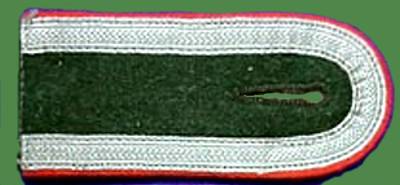NCOs insignia was displayed in two places; on the collar of the uniform (also cuffs of the Waffenrock), and on the shoulder straps. The collars of field blouses were edged in tress (lace) by NCOs, running along the bottom and front of the collar. On the Waffenrock and the prewar Dienstrock, the tress was sewn to the top and front of the collar instead. COLLARS AND CUFFS
At left, a Waffenrock showing the collar tress on top and front of the collar. At centre a Reichswehr period Dienstrock showing the tress on the top of the collar, worn as a dress uniform, and at right, the standard feldbluse showing tress worn on the bottom of the collar.
SHOULDER STRAPS Standard enlisted men's shoulder straps were worn by NCOs, with two major differences. NCO tress was worn on the shoulder strap, and for those NCOs ranked Feldwebel or higher, metal unit devices were used rather than embroidered.
|














